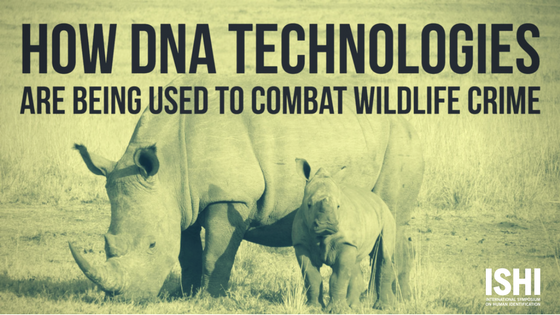Poachers have been reaping financial rewards while depleting wildlife populations for years, and they’ve been notoriously hard to catch and prosecute. Thankfully, recent developments in DNA technology have begun to give investigators the tools they need to put these poachers behind bars.
Written by: Tara Luther, Promega
In 2013, the Convention on International Trade on Endangered Species (Cites) officially recognized the importance of wildlife forensics, and at the most recent meeting in Johannesburg in September of 2016, forensics was a main topic of conversation.
In the past five years, many countries have begun to fund wildlife forensic labs, such as Malaysia, Thailand, Vietnam, Botswana, Kenya, and South Africa.
What Is Wildlife Crime?
Wildlife crime is the illegal trade of animals and plants (including their derivatives). Crime can lead to the depletion of natural resources, invasion of pest species, a reduction in animal populations, and transmission of diseases.
Wildlife crime can take many forms: trafficking live animals, hunting out of season, cruelty to animals, habitat destruction, and poaching (for either meat, trophies, medicines, or jewelry making). Though mammalian species, such as the black rhino or tiger, receive more public attention, crimes involving reptiles or amphibians are more frequent, as these animals are smaller and easier to conceal.
Until recently, wildlife crime investigators mainly focused on seizing contraband, identifying species from a seized shipment, and prosecuting those they could – usually lower level poachers. With the advancement of technology and training, investigators are able to predict where poachers will be and identify trafficked specimens sooner.
How DNA Technologies Are Being Used to Combat Wildlife Crime Share on X
Why has Wildlife Crime Been Notoriously Hard to Solve?
Though advances have been made, wildlife crime continues to pose challenges for investigators. Since wildlife crimes are frequently committed in remote areas, it can take several hours or even days to discover a crime scene. For example, Kruger National Park (South Africa’s largest game reserve) is 7,523 square miles, which is slightly larger than Connecticut and Rhode Island put together. There, it can take days or weeks before a poaching crime scene is located. In the meantime, the crime scene has been exposed to the weather and scavengers.
Typically, forensic laboratories (and those with forensic science expertise) are located in urban areas away from the crime scenes. Those processing the crime scene for evidence need to be able to hand carry their equipment to the crime scene, and are not always familiar with procedures for recovering DNA.
For instance, Anti-Poaching Unit (APU) Rangers in South Africa do an excellent job of photographing and preserving crime scenes, casting and collecting footwear impressions, and recovering items for toolmark impressions. The APU Rangers are not as knowledgeable in DNA evidence, however, and frequently do not collect latent prints or DNA from water bottles left at the crime scene.
A major challenge is that real-world applications differ greatly from methods used in case studies. Developing tools that distinguish between hundreds of species and geographic regions requires investment in research and development.
You May Also Like:
How Can DNA be Used to Help Solve Wildlife Crime?
DNA analysis used in animal cases is similar to what is currently used in human cases. It works by targeting specific genetic markers that are highly variable within species, making them likely to show a difference between individual animals.
By separating out these markers from physical samples (such as a rhino horn or a piece of rosewood), forensic scientists are often able to determine where the animal or plant came from, what its parentage might be, the age of the sample, and how this relates to other seized shipments. Occasionally, it’s possible to uncover more information about the criminal networks behind the trade, by detailing where the plants or animals were killed and which ports were used to transport them.
In the video below, Lindsay Monderman (a Forensic Biologist with the Alberta Fish and Wildlife Unit), describes the process her laboratory used to catch a Grizzly Bear poacher from a single hair in a truck bed.
In What Areas Have DNA Technologies Already Made an Impact?
Tigers
In Nepal and south-east Asia, conservationists have been mapping tiger populations using genetic information from scat. Tigers tend to be solitary animals and are hard to track, but determining where tigers will be found may also lead to locating poachers.
Sharks
Shark fins are used to make shark fin soup, a Chinese delicacy. Fins can be difficult to identify, once they have been separated from the animal, skinned, and processed. A study done in 2015 used genetic markers to show that even in areas where shark fin soup is legal, the fins used in the soup may come from protected and illegally traded animals. Similar genetic data has been used to prosecute poachers in the US and Australia.
Rhinos
Similar to the Offender Data Information System (ODIS) used in the US, the University of Pretoria has created ‘rhODIS’ – a genetic database of DNA samples from black and white rhinos throughout the South Africa. This database will be used to help match recovered rhino horn to individual and poached rhinos by comparing the genetics of the seized horn to those in the database.
Elephants
The Gabon park system is compiling a database of poached elephant DNA, and Thailand is establishing a DNA registration system for all domesticated elephants in order to distinguish them from wild elephants.
Samuel Wasser, director of the Center for Conservation Biology at the University of Washington in Seattle, spearheaded an effort to create a genetic database of ivory tusks from 28 large seizures taking place between 1996-2014. His team discovered that most elephants were killed in four areas of the African continent, and most major seizures came from two regions; savanna elephants were poached in south-eastern Tanzania and Mozambique, and forest elephants were poached in Gabon, Congo, and the Central African Republic. With this information, it may be possible to catch poachers before they strike.
Black Bears
Though bears are not being hunted in US National Parks, DNA is saving them all the same. In the past, when a bear attack was reported, rangers were forced to kill any bears they suspected of causing the attack. Now, DNA evidence taken from the attack site can be used to link a suspected bear to the attack or show that the bear was innocent.
Timber
Most timber laws protect individual species, and sometimes only part of the range of that species. Even for experts, timber can be very hard to identify, and by looking at the structure of the wood alone usually leads to identification at the genus level, but not the species level.
New identification techniques include genetic and chemical fingerprinting, that can provide more detail and determine the type and source of timber with great accuracy.
Going Forward
While DNA technology has greatly improved the odds that wildlife criminals will be caught and brought to justice, there are still some obstacles that remain. Such issues as data sharing, lab and sample collecting standards, and budgets need to be examined.
The Society for Wildlife Forensic Science and the United Nations Office on Drugs and Crime presented a survey of wildlife forensic capability at last year’s Cites meeting. In the survey, they administered a questionnaire to 39 countries. The results showed that of the labs surveyed, only ½ operated according to any quality assurance standard, 1/3 cooperated internationally, ¼ reported being involved in legal cases, and only 6 labs in the world have been audited by any external accrediting agency.
The report does point out, however, that standardization in the field is relatively new, and hopes that these numbers will shift for the better in the coming years. Currently, the Society for Wildlife Forensic Science has approximately 150 members in 60 labs and has begun to circulate an international test for certifying laboratories.
WOULD YOU LIKE TO SEE MORE ARTICLES LIKE THIS? SUBSCRIBE TO THE ISHI BLOG BELOW!


